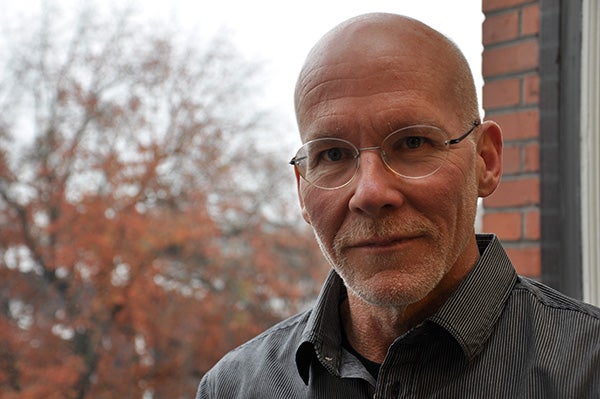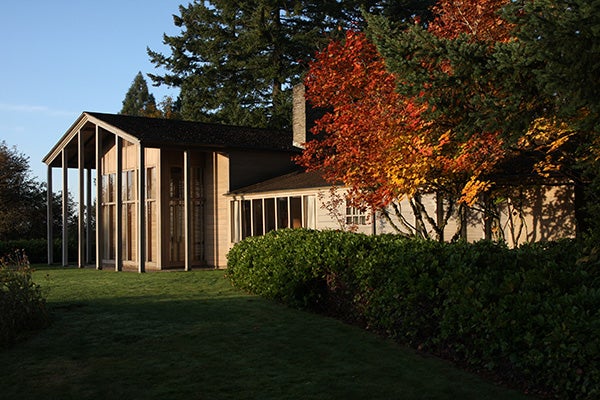The University of Oregon has hired Portland writer, editor, and organizer Randy Gragg to lead the John Yeon Center. Gragg is best known as a writer on architecture, and urban issues for The Oregonian, from 1989 to 2007, and for his role as editor in chief of Portland Monthly, where he will continue as editor at large. The John Yeon Center is an educational and research program of the UO School of Architecture and Allied Arts.

Above: Randy Gragg, executive director, John Yeon Center, School of Architecture and Allied Arts, University of Oregon. Photography by Sabina Samiee.
Gragg has actively promoted the work and legacy of John Yeon since he met him three years before Yeon’s death in 1994. He has written essays and articles, organized exhibitions, and presented lectures on the work of the man who is regarded as one of the Pacific Northwest’s leading architects for the Modern regional style and an advocate for conservation of the Columbia River Gorge and the Oregon Coast.
Gragg will lead the center that manages three important Yeon-designed properties, and will build programs to support the vision of the center. “The Yeon Center can be a standard-bearer for the preservation of the region’s greatest works of architecture and landscape design,” Gragg says. “I hope to make the Watzek House, Cottrell House, and The Shire places for architects, planners, researchers, policy makers, and visionaries to convene and be inspired to shape the best possible futures for the region.”
Frances Bronet, dean of the UO School of Architecture and Allied Arts, says “Randy’s deep connection to Portland’s built environment, his ability to create powerful narratives about community and place, and his knowledge and leadership of historic preservation and public projects make him ideally suited to lead our John Yeon Center. The lessons of John Yeon’s ideas and work can foster meaningful contributions to our public discourse about design, architecture, planning, and conservation. We are delighted he has joined the university at this important moment.”
Gragg is savoring the chance to meld a long-term interest with his new UO endeavor. “In a way, promoting John Yeon’s legacy has been an ongoing side project [of mine] for nearly 20 years,” Gragg said in an interview in Brian Libby’s Portland Architecture blog. “His work and his thinking has been so inspirational to me. So I’m thrilled that UO is giving me the opportunity to really focus on developing the Yeon Center and the properties into inspirational experiences for the wider community.”
Gragg will be based at the University of Oregon in Portland located at the White Stag Block. He will focus his efforts on program development, building educational connections, and fundraising that bring attention and support to the outstanding work of Yeon and the significance of the properties and ideas that form the basis of the John Yeon Center.
Gragg helped found and is board president of the Halprin Landscape Conservancy, a nonprofit organization devoted to preservation and enhancement of Lawrence Halprin’s landmark quartet of fountain plazas in Portland’s South Auditorium District. He also serves on the board and chairs the programming committee for Portland’s world-renowned Pioneer Courthouse Square. Gragg was a Loeb Fellow at Harvard University’s Graduate School of Design in 2005-06.

Above: The Watzek House in Portland was designated a National Historic Landmark in 2011. Photograph by Jack Liu.
Established in 1995, the purpose of the Yeon Center is to advance the ideals and principles of Yeon through research, publications, and focused study groups, and to explore critical issues in architecture, landscape architecture, and other fields. The John Yeon Center is comprised of the Watzek house, a National Historic Landmark; the George and Margaret Cottrell House; and The Shire.
Yeon (1910-1994) was nationally regarded as a regional pioneer in the fundamental rethinking of art and architecture for the 20th century. A native Oregonian, and largely self-taught, his brilliant and wide-ranging design work includes buildings, interiors, gardens, landscapes, furnishings, and museum installations.
“Whether designing a house or a garden or a landscape like The Shire, John Yeon had a rare, comprehensive vision for how the built and natural environment could comingle,” Gragg says. “He was a conservationist to the core, but one who saw development and change less as threats than as opportunities for beauty.”

Above: The Shire in the Columbia River Gorge is a 75-acre designed landscape created by John Yeon. Photograph courtesy University of Oregon.
